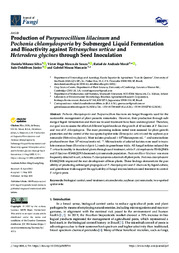Production of Purpureocillium lilacinum and Pochonia chlamydosporia by submerged liquid fermentation and bioactivity against Tetranychus urticae and Heterodera glycines through seed inoculation.
Production of Purpureocillium lilacinum and Pochonia chlamydosporia by submerged liquid fermentation and bioactivity against Tetranychus urticae and Heterodera glycines through seed inoculation.
Autoria: SILVA, D. M.; SOUZA, V. H. M. de; MORAL, R. de A.; DELALIBERA JÚNIOR, I.; MASCARIN, G. M.
Resumo: Abstract: Pochoniachlamydosporia and Purpureocilliumlilacinum are fungal bioagents used for the sustainable management of plant parasitic nematodes. However, their production through submerged liquid fermentation and their use in seed treatment have been underexplored. Therefore, our goal was to assess the effect of different liquid media on the growth of 40 isolates of P. lilacinum and two of P. chlamydosporia. The most promising isolates tested were assessed for plant growth promotion and the control of the two-spotted spider mite (Tetranychus urticae) and the soybean cyst nematode (Heterodera glycines). Most isolates produced > 108 blastospores mL−1 and some isolates produced more than 104 microsclerotia mL−1. Microsclerotia of selected isolates were used to inoculate common bean (Phaseolus vulgaris L.) seeds in greenhouse trials. All fungal isolates reduced the T. urticae fecundity in inoculated plants through seed treatment, while P. chlamydosporia ESALQ5406 and P. lilacinum ESALQ2593 decreased cyst nematode population. Purpureocillium lilacinum was more frequently detected in soil, whereas P. chlamydosporia colonized all plant parts. Pochonia chlamydosporia ESALQ5406 improved the root development of bean plants. These findings demonstrate the possibility of producing submerged propagules of P. chlamydosporia and P. lilacinum by liquid culture, and greenhouse trials support the applicability of fungal microsclerotia in seed treatment to control P. vulgaris pests.
Ano de publicação: 2022
Tipo de publicação: Artigo de periódico
Unidade: Embrapa Meio Ambiente
Palavras-chave: Biological control, Biological control agents, Controle Biológico, Cyst nematodes, Fermentação, Fungo Para Controle Biológico, Heterodera Glycines, Liquid state fermentation, Microsclerotia, Mites, Nematóide, Seed treatment, Soybean cyst nematode, Tetranychus Urticae, Two-spotted spider mite, Ácaro
Observações
1 - Por padrão são exibidas publicações dos últimos 20 anos. Para encontrar publicações mais antigas, configure o filtro ano de publicação, colocando o ano a partir do qual você deseja encontrar publicações. O filtro está na coluna da esquerda na busca acima.
2 - Para ler algumas publicações da Embrapa (apenas as que estão em formato ePub), é necessário ter, no celular ou computador, um desses softwares gratuitos. Sistemas Android: Google Play Livros; IOS: iBooks; Windows e Linux: software Calibre.
Acesse outras publicações
Acesse a Base de Dados da Pesquisa Agropecuária (BDPA) para consultar o acervo completo das bibliotecas da Embrapa.

